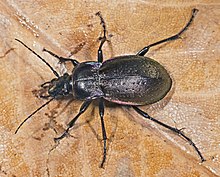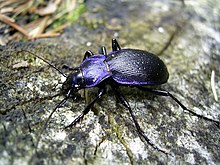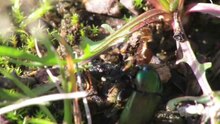Ground beetle
| Ground beetle | ||||||||||||
|---|---|---|---|---|---|---|---|---|---|---|---|---|

Golden ground beetle ( Carabus auratus ) |
||||||||||||
| Systematics | ||||||||||||
|
||||||||||||
| Scientific name | ||||||||||||
| Carabidae | ||||||||||||
| Latreille , 1802 |
The ground beetles (Carabidae) represent a very species-rich family of beetles (Coleoptera). They are distributed worldwide with the exception of the Antarctic and are known with over 40,000 species in 1,500 genera. In Europe they occur with almost 6000 species and subspecies, in Central Europe around 85 genera with almost 760 species are known. Whether the tiger beetles (Cicindelinae), the bombardier beetles (Brachininae) and the ground beetles (Omophroninae) contained in this family should be separated out as separate families is seen differently by the systematics.
features
Beetle


The beetles are 1 to 85 millimeters long. As a rule, they have a flattened and elongated body with a clearly pronounced angle between the pronotum and the winglets (elytra). The dorsal side of the body is rarely convex and the body sides are evenly rounded, as is the case with the genus Omophron . The body surface is usually smooth and shiny. Most types are black or dark in color, some types have a metallic sheen. Some species, such as those of the genera Cicindela and Eurynebria , or the Omophroninae, lack pigmentation in parts of the body, resulting in conspicuous patterns. Small, angled, irregularly arranged hairs may be present or absent. Sometimes they form fluffy surfaces. There are also species with long, angled setae.
The head is directed forward and relatively elongated. It is moderately retracted into the prothorax. A characteristic neck area is missing. The compound eyes are usually well developed and are prominent. However, there are various types of regression, up to and including complete absence. The feelers are almost always thread-shaped. They are eleven. The third or fourth to eleventh links have fine flowers. Sometimes the basal limbs are also fluffed, but then only less densely than in the other limbs. The mandibles have the basic shape of a three-sided pyramid, with the dorsal, ventral and outer surface being moderately to very elongated. The mandibular palps ( maxillary palps ) are four-part, the labial palps three-part.
The prothorax is rounded at the sides and more or less tapered at the back. With a few exceptions, it is significantly narrower at the rear edge than the base of the wing. The pronotum is divided in the middle by a longitudinal line, usually has an upturned lateral edge and clear indentations at the base. The indentations of the hips ( coxes ) of the front legs are open, with no internal postcoxal bridge or closed externally. The rails ( tibia ) of the forelegs usually have one or two spurs on top. An organ is designed to clean the antennae on the tibia. The scutellum is enclosed by the base of the cover wing, or shifted forward. The indentations of the middle hips are laterally open or closed. The wing covers usually completely cover the tergites of the abdomen, in some species the tips are truncated. The cover wings each have eight longitudinal stripes and nine areas in between. Setae are usually formed in the third, fifth and ninth intermediate areas, sometimes also in the first and seventh. The metanotum is typical of the suborder Adephaga , but is shortened and, in wingless species, greatly simplified in its form.
The abdomen usually has six visible sternites . The second can only be seen from the side in most species. The large median part of the second sternite is usually formed in species with clearly separated middle hips. The third and fourth sternite are grown together. The first through eighth tergites have spirals .
Larvae
The larvae are elongated, have a rectangular head and are mobile with long thoracic legs (campodeiform). They are moderately flattened and have almost parallel edges. The sclerotized areas are brownish to black. The head is directed forward and laterally rounded or roughly square. On the side of the head there are six point eyes ( stemmata ), which are arranged in two rows. The antennae are four-sided and directed forward. The first two limbs are almost cylindrical, the third has a pear-shaped sensory area on the side. The fourth link is smaller and rounded at the tip. The maxillary palps are four-parted or three-parted and pivoted on the palpifer , the labial palps are two-parted. Large spiracles are formed between the pro- and mesothorax. The legs are five-limbed and usually have two claws. The first to eighth tergites on the abdomen are built similarly and have a keel at the front and the ecdysial suture in the middle. Sternites, epipleurons , hypopleurons and a lateral stigma lie ventrally and laterally . The ninth abdomen segment is smaller and has fused sternites. The ninth tergite usually carries a pair of long, slender urogomphi . In many groups of ground beetles, the body structure of the larvae is heavily modified. For example, the legs are receded or the abdomen is greatly expanded ( physogastric ).
Occurrence
The family, spread around the world, inhabits all terrestrial habitat forms from the subarctic to the humid tropical regions. With the exception of the species that inhabit tropical rainforests and subtropical mountain forests, most species live on the ground. Imagines and larvae live in the ground, in the leaf litter or are active on the ground. Some species climb bushes and other plants. Many species, especially within the tribe Trechini , Anillini and Platynini, colonize caves or deep micro-caves in the ground. Although many species inhabit humid habitats, only a very few species are known to be amphibious, such as the pit beetle ( Carabus variolosus ), which also hunts in small rivers. Many species of tropical rainforests and subtropical mountain forests as well as a few species of temperate latitudes live in trees and rest under leaves or bark.
Way of life
The majority of ground beetles can fly and so spread well. There are species in which not only normally developed individuals appear, but also those in which the muscles and the wings are regressed. Only a few species, such as most common ground beetles ( Carabus ) or the species of the Anthiini tribe, have no hind wings. But these species also have enormous potential to spread. The real ground beetles have been shown to have propagation speeds of 77 meters per night and running speeds of 0.16 meters per second. Ground beetles have a circadian rhythm and outside the tropics also have a seasonal rhythm. The mating behavior is adjusted according to the seasonal rhythm. Most species are nocturnal, only a few such as the Cicindelini are diurnal. However, there are also species that change their activity depending on climatic factors or the season. The diapause in winter of subtropical and temperate species occurs in different ways. This ranges from complete inactivity in a hiding place to hiding only during the day to the aggregation of several hundred animals.
As far as is known, the females of the ground beetles lay their eggs individually or in small groups in small depressions in the substrate or under the bark, or in shells made of mud or algae and bark. A female lays four to several hundred eggs. At Colpodes buchanani z. B. 660 eggs detected in a female. Development in the egg takes a few days to several weeks. Most larvae go through three stages. With some kinds of Zabrini, Harpalini, Lebiini and Anthiini there are only two. This is probably related to life in arid habitats. In some species of Lebiini and Brachinini, the larvae also go through four or five stages, which is presumably an adaptation to their ectoparasitic way of life. The pseudomorphini are ovoviviparous . With some species of Pterostichini brood care can be observed. The females guard their eggs and also lay the eggs in individual earth cells that are filled with food. Pupation usually takes place in moist soil. The fully developed larva digs a doll's cradle with its head and legs . Only in Thermophilus sexmaculatum does the larva dig the pupa cradle in the first stage and spend its second and last stage motionless in the cradle. The life expectancy of the beetles is up to four years, although they usually live at least more than a year in the temperate latitudes.
Both the larvae and the adults have a partially extraintestinal digestion . The prey is rotated by the mandibles and maxillae while digestive juices are pushed up on them. The adults of most species are omnivorous , although the predatory diet predominates. There are a few groups that specialize in plant-based nutrition, such as the genus Zabrus , or some species of the Harpalini. In addition, tree-dwelling species of the genus Agra could be observed eating flowers and nectar. Much less is known about the feeding behavior of the larvae. Most species are likely to be predatory. A number of species specialize in hunting certain prey, such as the Cychrini and Licinini for snails, the Nebriini, Notiophilini and Loricerini for springtails , or the Anthiini, Graphipterini, Metriini and Ozaenini for ants or their brood. The larvae of the Paussini and Pseudomorphini can probably be fed by ants, the Lebiini and Brachinini, as far as known, ectoparasites on insect eggs and pupae. The larvae of the Cicindelinae and Ozaenini live in pits and lie in wait at the entrance to overwhelm prey. The larvae of various Harpalini are specialized in eating seeds.
Very few ground beetles are counted among the pests . Only Zabrus tenebrioides is of economic importance in terms of grain, but only in certain areas of East Germany, Moravia and the Ukraine and only at certain times. Little research has been done into the ecological significance of the very diverse family. The ground beetles represent a large part of the invertebrate predators of the ground fauna, for example in forests of temperate latitudes. Due to their large number and occurrence in all habitats, an important ecological function can be assumed.
Natural enemies
The natural enemies of ground beetles include not only non-specific insectivores, such as bats, rodents, birds, amphibians, reptiles, ants, woodlice and spiders endoparasites of Apicomplexa , nematodes (genera Mermis and Hexamermis ) and string worms (genus Gordius ) and ectoparasites of mites ( Trombidiiformes and Sarcoptiformes ). In addition, many other types of mites, such as those of the genus Parasitus , appear on ground beetles, but use them only as transport hosts ( phoresia ).
Parasitoids that attack ground beetles are known from the hymenoptera genera Proctotrupes on Harpalinae and Carabinae , Microtonus on Harpalinae and Methocha on Cicindelinae . Fly from the family of Larvaevoridae parasitize in several sub-families, the genus Anthrax to Cicindelinae. In addition to unspecific parasitic fungi, 16 genera with several hundred species of Laboulbeniales are known on ground beetles.
Endangerment of ground beetles
Many species of ground beetle are dependent on very special habitats and living conditions. Due to the increasing destruction of natural ecosystems and biotopes, these extremely adapted species have in some cases been reduced in their occurrence to such an extent that they are now considered to be highly endangered and are accordingly listed on the Red List . Large species are particularly affected. Since the layperson cannot be expected to be able to distinguish all species, all conspicuously large species were placed under the provisions of the German Federal Species Protection Ordinance. This applies to all species of the real ground beetle ( Carabus ), the pupa predator ( Calosoma ) and the shovel runners ( Cychrus ). The tiger beetles (Cicindellinae) are also completely protected for the reasons given. Species such as Mecodema punctellum from Stephens Island (New Zealand) and Aplothorax burchelli from St. Helena are believed to have died out.
Taxonomy and systematics
The ground beetles are divided into the following subfamilies:
- Carabinae Latreille , 1802
- Tiger beetle (Cicindelinae) Latreille , 1802
- Elaphrinae Latreille , 1802
- Gehringiinae Darlington , 1933
- Harpalinae Bonelli , 1810
- Hiletinae Schiödte , 1847
- Loricerinae Bonelli , 1810
- Migadopinae Chaudoir , 1861
- Ground beetle (Omophroninae) Bonelli , 1810
- Antennae beetles (Paussinae) Latreille , 1802
- Scaritinae Bonelli , 1810
- Siagoninae Bonelli , 1810
- Trechinae Bonelli , 1810
- Bombardier Beetle (Brachininae) Bonelli , 1810
- Pseudomorphinae Newman , 1842
Types (selection)
- Badister bullatus
- Yellow-tipped green beetle ( Chlaeniellus vestitus )
- Microlestes maurus
further types (selection) are listed under the subfamilies
supporting documents
Individual evidence
- ↑ a b c d e f g h i j k l m n Rolf G. Beutel, Richard AB Leschen: Handbuch der Zoologie - Coleoptera, Beetles, Volume 1: Morphology and Systematics (Archostemata, Adephaga, Myxophaga, Polyphaga partim) . 1st edition. de Gruyter , 2005, ISBN 3-11-017130-9 , p. 119 ff . (English).
- ↑ Carabidae. Fauna Europaea, accessed March 28, 2013 .
- ^ Karl Wilhelm Harde , František Severa : Der Kosmos-Käferführer. The Central European beetle . Franckh-Kosmos, Stuttgart 2000, ISBN 3-440-06959-1 , p. 96 ff .
literature
- Rolf G. Beutel, Richard AB Leschen: Handbuch der Zoologie - Coleoptera, Beetles, Volume 1: Morphology and Systematics (Archostemata, Adephaga, Myxophaga, Polyphaga partim) . 1st edition. de Gruyter , 2005, ISBN 3-11-017130-9 (English).
literature
- E. Arndt: Family Carabidae. In: B. Klausnitzer (Hrsg.): The larvae of the beetles of Central Europe 1, Adephaga. Goecke & Evers, Krefeld 1991, ISBN 3-87263-041-5 .
- German Youth Association for Nature Observation (DJN): ground beetles. 4th edition. 2006, ISBN 3-923376-18-9 . (Identification key for all genera)
- WF Erichson: Natural history of the insects of Germany. First division of Coleoptera. 1st volume, 1st half, Nicolaischer Verlag, Berlin 1860.
- H. Joy: Adephaga, 1. Carabidae. In: H. Freude, KW Harde, GA Lohse: Die Käfer Mitteleuropas. Volume 2: Adephaga 1. Goecke & Evers, Krefeld 1976, ISBN 3-87263-025-3 .
- Gerd Müller-Motzfeld : The Beetles of Central Europe. Volume 2, Fischer, Krefeld 2004, ISBN 3-8274-1551-9 .
- T. Mrozek-Dahl: The animal world of Germany and the adjacent parts of the sea according to their characteristics and their way of life. 7th part: Coleoptera or beetles I: Carabidae (ground beetles). G. Fischer, Jena 1928, OCLC 6883839 .
- E. Reitter: Fauna Germanica. The beetles of the German Empire. I. Volume, KG Lutz, Stuttgart 1908, DNB 367746972 .
- J. Trautner, K. Geigenmüller: Tiger beetles, ground beetles. Illustrated key to the Cicindelids and Carabids of Europe. Margraf, Weikersheim 1987, ISBN 3-924333-04-1 .
- Ekkehard Wachmann , Ralph Platen, Dieter Barndt: Ground beetles - observation, way of life. Naturbuch-Verlag, Augsburg 1995, ISBN 3-89440-125-7 .
- Jiři Zahradnik, Irmgard Jung, Dieter Jung, Jarmila Hoberlandtova, Ivan Zpevak: Beetles of Central and Northwestern Europe. Parey, Berlin 1985, ISBN 3-490-27118-1 .
- Jürgen Trautner (Ed.): The ground beetles of Baden-Württemberg. 2 volumes. Verlag Eugen Ulmer, Stuttgart 2017, ISBN 978-3-8001-0380-5 .
Web links
- Society for Applied Carabidology ( Memento from July 13, 2014 in the Internet Archive )
- Carabidae of the World: Scientific database on ground beetles ( Memento of August 7, 2011 in the Internet Archive )
- Identification key to the ground beetles in Baden-Württemberg
- Mapping of ground beetles in the district of Konstanz (Baden-Württemberg)
- Endemic deciduous ground beetles in Bavarian beech and ravine forests ( Memento from September 10, 2011 in the Internet Archive )
- Large photo collection of European ground beetles


